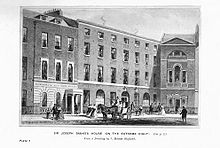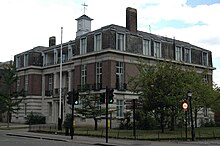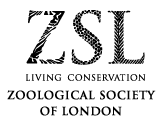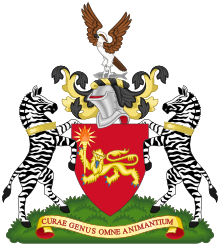Zoological Society of London
Non-profit organisation | |
| Purpose | To promote worldwide conservation of animals and their habitats; London Zoo and Whipsnade Zoo, research in Institute of Zoology, field conservation |
|---|---|
| Location |
|
| Coordinates | 51°32′09″N 0°09′27″W / 51.5357°N 0.1575°W |
| Website | www |
The Zoological Society of London (ZSL) is a charity devoted to the worldwide
History



On 29 November 1822, the birthday of

The society was founded in April 1826 by

The purpose of the society was to create a collection of animals for study at leisure, an associated museum and library. In April 1828, the Zoological Gardens were opened to members. In 1831
A History of the ZSL, written by Henry Scherren (FZS), was published in 1905.[3] The History was criticised as inadequately researched by Peter Chalmers Mitchell in 1929; both histories were labelled inaccurate by John Bastin in 1970.[5]

As the twentieth century began, the need to maintain and research large animals in a more natural environment became clear. Peter Chalmers Mitchell (ZSL Secretary 1903–35) conceived the vision of a new park no more than 70 miles (110 km) away from London and thus accessible to the public, and at least 200 acres (0.81 km2) in extent. In 1926, profiting from the agricultural depression, the ideal place was found: Hall Farm, near
. In 1931 Whipsnade Park was opened to the public as the world's first open zoological park.In 1960–61,
The Society is a registered charity under English law.[6]
The Institute of Zoology
The Institute of Zoology is the scientific research division of the ZSL. It is a government-funded research institute, which specialises in scientific issues relevant to the conservation of species and their habitats. The Institute of Zoology focuses its research on five areas: evolutionary biology, genetics, ecology, reproductive biology and wildlife epidemiology. The Institute of Zoology was graded 4 in the 1997–2001 UK Research Assessment Exercise, and publishes reports annually. From the late 1980s the Institute of Zoology had been affiliated to the University of London. However, in 2000 this was replaced with a partnership with the University of Cambridge.
Zoos and publications
ZSL runs
Awards
The society administers the following award programmes:[7]
- Frink Medal
- Stamford Raffles Award
- Silver Medal
- ZSL Scientific Medal[8]
- Marsh Award for Conservation Biology
- Marsh Award for Marine and Freshwater Conservation
- Thomson Reuters/Zoological Record Award for Communicating Zoology
- Prince Philip Award and Marsh Prize
- Charles Darwin Award and Marsh Prize
- Thomas Henry Huxley Award and Marsh Prize
- the Landseer Medal
Fellows
Individuals can be elected Fellows of the Zoological Society of London and therefore granted the post-nominal letters FZS.
Honorary Fellows
The ZSL's Honorary Fellows include:[9]
- 1975: Jean Anthony, Jean Dorst
- 1977: Prince Philip, Duke of Edinburgh
- 1984: Ernst Mayr
- 1988: Milton Thiago de Mello
- 1990: Knut Schmidt-Nielsen
- 1991: Emperor Akihito of Japan
- 1992: Edward O. Wilson
- 1996: John Maynard Smith
- 1997: Miriam Rothschild
- 1998: Sir David Attenborough
- 1999: Sir Robert May
- 2001: Patrick Bateson
- 2002: Robert McNeill Alexander, CBE, FRS
- 2002: William G. Conway
- 2003: Brian Follett
- 2004: Sir Martin Holdgate
- 2005: Sir Brian Heap
- 2006: Sir John Lawton
- 2007: John Beddington
- 2011: Lord Moser
- 2012: Desmond Morris
- 2013: Ken Sims
Council
The council is the governing body of the ZSL. There are 15 council members, led by the president and served by the secretary and treasurer. Council members are the trustees of the society and serve for up to five years at a time.[10]
Presidents
The Presidency is a voluntary position, with the role of leading the ZSL Council. The Society's Presidents and their dates in office are:[11]
- Sir Stamford Raffles(1826)
- Henry Petty-Fitzmaurice, 3rd Marquess of Lansdowne (1827–1831)
- Edward Smith-Stanley, 13th Earl of Derby (1831–1851)
- Prince Albert, Prince Consort(1851–1862)
- Sir George Clerk, Bt (1862–1868)
- Arthur Hay, 9th Marquess of Tweeddale (1868–1878)
- Sir William H. Flower(1879–1899)
- Herbrand Russell, 11th Duke of Bedford (1899–1936)
- Richard Onslow, 5th Earl of Onslow (1936–1942)
- Henry Gascoyne Maurice (1942–1948)
- Edward Cavendish, 10th Duke of Devonshire (1948–1950)
- Alan Brooke, 1st Viscount Alanbrooke (1950–1954)
- Sir Landsborough Thomson(1954–1960)
- Prince Philip, Duke of Edinburgh (1960–1977)
- Solly Zuckerman, Baron Zuckerman (1977–1984)
- Sir William MacGregor Henderson (1984–1989)
- Avrion Mitchison (1989–1992)
- Field Marshal Sir John Chapple (1992–1994)
- Sir Martin Holdgate (1994–2004)
- Professor Sir Patrick Bateson (2004–2014)
- Professor Sir John Beddington, CMG, FRS (2014–2022)
- Professor Sir Jim Smith FRS (2022–Present)
Secretaries
The post of secretary is honorary and under the society's constitution carries the responsibility for the day-to-day management of the affairs of the ZSL. The secretaries and their dates in office are:[12][13]
- Nicholas Aylward Vigors (1826–1833)
- Edward Turner Bennett (1833–1836)
- William Yarrell (1836–1838)
- John Barlow(1838–1840)
- William Ogilby (1840–1847)
- David William Mitchell (1847–1859)
- Philip Lutley Sclater(1859–1902)
- William Lutley Sclater (1903)
- Peter Chalmers Mitchell (1903–1935)
- Julian Huxley (1935–1942)
- Sheffield Airey Neave (1942–1952)
- Anthony Chaplin, 3rd Viscount Chaplin (1952–1955)
- Solly Zuckerman, Baron Zuckerman (1955–1977)
- Ronald Henderson Hedley(1977–1980)
- Erasmus Darwin Barlow (1980–1982)
- John Guest Phillips(1982–1984)
- Richard M. Laws(1984–1988)
- Barry Albert Cross(1988–1992)
- Professor Robert McNeill Alexander, CBE, FRS (1992–1999)
- Paul H. Harvey (2000–2011)
- Professor Geoffrey Boxshall, FRS (2011–2021)
- Professor Sir Jim Smith FRS (2021–2022)
Coat of arms

|
|
Notes
- ^ "Zoological Society of London | Tethys". tethys.pnnl.gov. Retrieved 16 May 2024.
- ^ "Communicating Nature Since 1788". The Linnean Society. Retrieved 16 May 2024.
- ^ a b c d Scherren, Henry (1905). The Zoological Society of London. Cassell & Co.
- ^ "Zoological Society". The Times. No. 12956. London. 2 May 1826. col C, p. 3.
- .
- ^ "Zoological Society of London, registered charity no. 208728". Charity Commission for England and Wales.
- ^ "ZSL scientific awards". Archived from the original on 11 December 2005. Retrieved 12 May 2009.
- ^ "1961 ff". Archived from the original on 6 December 2023. Retrieved 18 November 2021.
- ^ "The Zoological Society of London Honorary Fellows" (PDF). Archived from the original (PDF) on 4 March 2016. Retrieved 12 May 2009.
- ^ "Current ZSL Council Members". Archived from the original on 1 March 2009. Retrieved 13 May 2009.
- ^ New president for ZSL promises public a gateway into conservation Archived 14 June 2009 at the Wayback Machine ZSL press release announcing the new president in 2004
- ^ The Zoological Society of London. Charter and Byelaws. 1995.
- ^ Denton, Peter (12 May 1994). "Obituary: Sir Barry Cross". The Independent. Archived from the original on 7 May 2022. Retrieved 14 October 2011.
- ^ "Zoological Society of London". Heraldry of the World. Archived from the original on 20 November 2022. Retrieved 25 September 2022.
External links
- Official website
- Proceedings of the Zoological Society of London from 1833 until 1923 in Biodiversity Heritage Library
- Bennett, Edward Turner (1830–31) The gardens and menagerie of the Zoological Society..., two volumes

